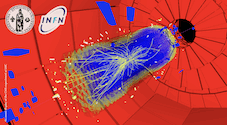Speaker
Mr
Julien Mekki
(CERN)
Description
The ‘Large Hadron Collider (LHC) is a complex radiation environment consisting of several particles types at different energies. The RadMon detector is conceived to measure the radiation effects on the electronics in the LHC tunnel and its adjacent shielded areas in order to monitor the radiation levels, anticipate possible device degradation and identify instantaneous failures of the electronic equipments, not correlated to their typical MTBF (Mean Time Between Failure) as caused by radiation. The RadMon monitoring aims also to validate the FLUKA Monte-Carlo calculations of the radiation environment. For these purposes, the RadMon provides the measurement of the Total Ionizing Dose in Silicon by means of RadFets, of the Displacement Damage (DD) in Silicon by means of p-i-n diodes, and of the High Energy Hadrons (HEH) and thermal neutrons fluence by counting Single Events Upsets (SEU) of SRAM memory. The calibration curves of the sensors have been measured in various certified facilities with different particle energies and also successfully applied to a mixed radiation field. The detailed characterization and evaluation of the detector system being used in an environment of mixed particle types and energies requires not only an extensive calibration campaign, but also leads to certain measurement limitations, both outlined in this paper. Currently in the LHC, about 400 RadMons, are continuously read out at a rate of one Hertz. The data acquisition and monitor control is assured via a field bus and special tools were developed to allow users to easily retrieve the data, as well as visualize the monitor locations. The important calibration efforts, together with the good coverage of monitors in the LHC accelerator successfully allowed for a detailed monitoring the LHC underground areas during the first two years of operation, confirming electronics failures due to radiation, relating them to the observed radiation levels, and providing detailed bench-marks for the FLUKA calculations.
Authors
Mr
Alessandro Masi
(CERN)
Mr
Alfredo Ferrari
(CERN)
Ms
Anna Nyul
(CERN)
Mr
Christian Pignard
(CERN)
Mr
Daniel Kramer
(CERN)
Mr
Giovanni Spiezia
(CERN)
Mr
Julien Mekki
(CERN)
Mr
Ketil Roeed
(CERN)
Mr
MArco Calviani
(CERN)
Mr
MArkus Brugger
(CERN)
Mr
Paul Peronnard
(CERN)
Mr
Roberto Losito
(CERN)
Mr
Thijs Wijnands
(CERN)
Mr
sergio Batuca
(cern)

